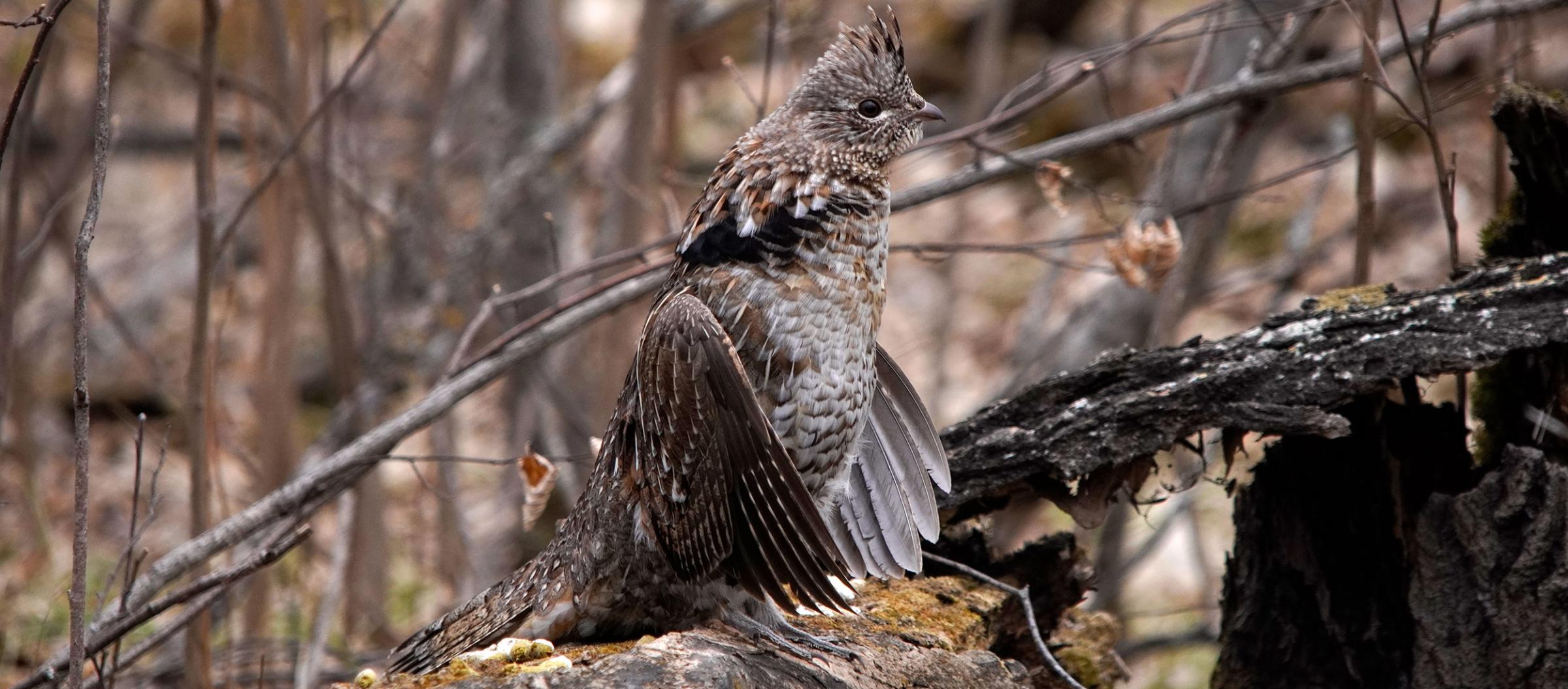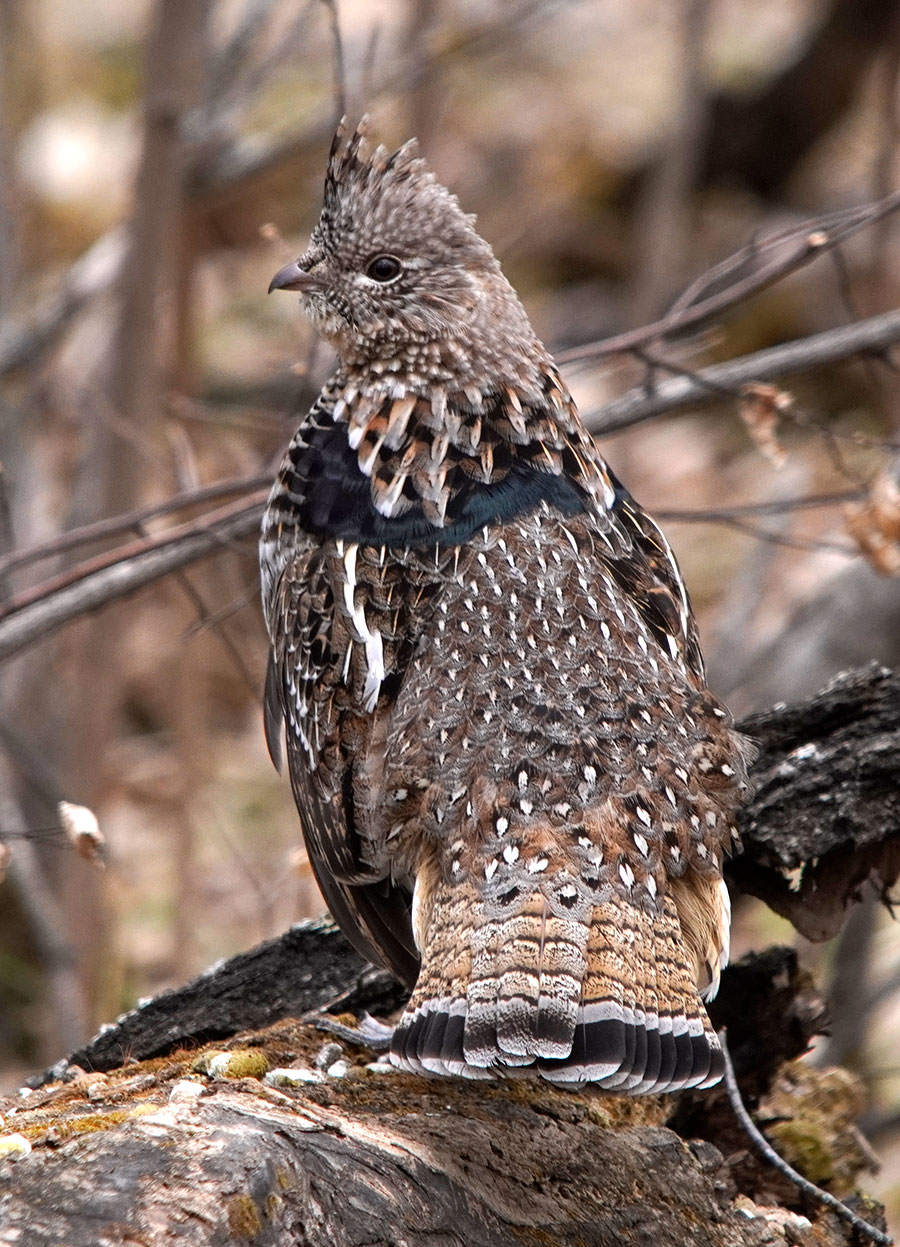North Dakota has four species of grouse, three of which live in mostly open habitat that offers something of an unhindered view. From sage grouse in the southwest, to greater prairie chickens on the state’s eastern shoulder, to sharp-tailed grouse in every county, these birds when flushed, can, and will, fly without interruption to the neighboring township if the mood strikes.
The fourth, the ruffed grouse, is a forest species that has turned its feathered back on North Dakota’s wide open because it must. Its dependence on mix-aged aspen woodlands and brushy undergrowth means its choices of accommodating habit is limited to the Turtle Mountains and Pembina Hills on the state’s northern tier.
You could argue that what links this grouse foursome is spring, the time of year males strut, stomp and drum in a single-minded effort to persuade mature female onlookers to breed.
“Male ruffed grouse find big, dead, downed aspen logs that end up being the perfect drumming sites,” said Jesse Kolar, North Dakota Game and Fish Department upland game management supervisor. “The grouse will walk up and down those logs, get to a spot where they can sit and beat their wings. That sound makes an echo that reverberates through forests.”
That sound signals to other males to stay away and alerts females to head thisaway.
“They'll pace that specific log day after day, morning after morning, and display each day from the end of March all the way through the middle of June,” Kolar said.
Ruffed grouse are likely the one grouse species most North Dakotans are unfamiliar with. While these birds will certainly wander out to gravel roads and two-tracks in the evening at whatever time of the year and show themselves to passersby, they’re not as conspicuous as our other grouse species that will, at times, sit in the mostly wide open where they can see danger coming from afar.
This inconspicuousness certainly translates during the breeding season when ruffed grouse drum in cover thick enough to provide protection from aerial predators.
“When they're on a log displaying, they're not going to be as easy to find as going out and finding sharp-tailed grouse dancing on a lek. They're going to be in thick forest. It's going to be in an area that's surrounded by cover and well protected,” Kolar said. “You’ll hear them drumming, which sounds like an old tractor trying to start before dying down, but it’s difficult to tell if they are 100 yards away or a half-mile. But if you do figure it out and get sort of close, you still might not be able to see them.”
Kolar said male ruffed grouse are habituated to one or two primary drumming logs. And you know when you’ve found one by the grouse scat scattered across the log.
“Also, the log itself eventually gets wore down and you'll see where they've been pacing back and forth, back and forth,” he said.
Game and Fish Department personnel, with the help this year from one North Dakota Parks and Recreation employee, survey ruffed grouse in the Turtle Mountains and Pembina Hills from April 1 through May 15.
Those conducting surveys run eight fixed routes where they stop and listen for drumming grouse for 5 minutes before moving on to the next stop.
“During their stops, they count how many drums they hear and then also try to estimate how many different males they think they hear,” Kolar said. “So, if it's a drum over here and a drum behind them, it might be two males versus just the same male drumming over and over.”
While the survey results for this spring weren’t completed at the time of this writing, Kolar said drumming counts last spring were down in the Turtle Mountains and were up, or about average, in the Pembina Hills.
Ruffed grouse are noted for cyclic fluctuations in population levels, which start high, decrease, then rise again every decade or so.
Even when North Dakota ruffed grouse populations are closer to boom than bust, bird numbers here never compare to those found in, say, Minnesota.
“We do have boom years where you go to the Turtle Mountains or the Pembina Hills and people see a lot more, but it's never been like what you'll see farther east,” Kolar said. “North Dakota is right on the periphery of the ruffed grouse range and that's usually what happens with most species. When you're near the periphery of a species’ range, there's just fewer of them.”
Like it is with any animal species, the limiting factor for not having a robust ruffed grouse population in North Dakota has much to do with habitat.
In northern latitudes, ruffed grouse are tied to aspen woodlands for both food and cover. Biologists say several age classes of aspen are needed for good grouse populations. Young aspen trees up to 10 years of age are used by broods, and in these young forests, ground cover and associated insects are found in abundance.
Middle-aged aspen stands (10-25 years) are used for food and winter cover. Older trees (25-40 years) are needed for nesting, drumming and feeding. In these older areas, brushy undergrowth is available for protection and the aspen produce good quantities of buds used as food.
“Ruffed grouse are specifically focusing on eating buds of aspen trees,” Kolar said. “That's their primary source of food, particularly in winter when there's no other food sources, no insects and not a lot of green vegetation for them to nip at.”
Biologists attribute long-term declines in North Dakota’s ruffed grouse population to the loss of aspen trees being cleared and converted to farmland.
For years, the Game and Fish Department, in cooperation with the North Dakota Forest Service, has worked to preserve remaining aspen forest habitat and manage what’s left standing to provide a diversity of aspen age classes for ruffed grouse and other animals.
“The work being done to allow those young aspen shoots to come up is not only good for grouse, but elk have been using those areas,” Kolar said. “We’ve also had a lot of songbirds that utilize that young, new growth of aspens.”
The pressure ruffed grouse in North Dakota feel from hunters in fall is likely insignificant. While it’s difficult to get a handle on the number of hunters who walk the wooded, public trails and bushwhack through thick cover to flush a bird, Game and Fish Department biologists feel the number is certainly low, especially when compared to those who hunt the state’s more celebrated upland game bird species.
For those who hunt this forest grouse, scarce competition is likely just how they like it. Whether ruffed grouse in the Turtle Mountains or Pembina Hills are climbing out of a low in the cycle or are at a high, it’s been said the ruffed grouse hunters fall isn’t complete without at least a trip or two to the grouse woods.
“For years we had wing envelope barrels in the Turtle Mountains and Pembina Hills and we'd get a lot of hunters submitting their ruffed grouse wings. The past five years we haven't been getting enough to do much with that data, but we still get some,” Kolar said. “They usually write a note on that envelope, and many of the hunters say, for example, they hunted four days, flushed one bird and shot zero, but still enjoyed being up there.”


